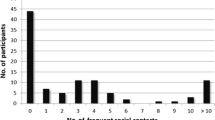Abstract
The reliability of the notion that pedophilia is caused by sexual abuse in childhood was explored by examining retrospective self-reports of 344 males. Included in the study were 77 heterosexual pedophiles, 54 homosexual pedophiles, 51 nonpedophilic sex offenders against children, 36 sex offenders against physically mature females, 75 heterosexual paid volunteers who erotically preferred mature females, and 51 homosexual clients who preferred mature males. For each sex offender the differential diagnosis of an erotic preference for minors vs. a preference for physically mature partners was made by means of the phallometric test of erotic gender and age preferences. The analysis of self-reports confirmed that the proportion of pedophiles who report having been sexually abused in childhood by mature persons is larger than that of men who were not charged for or accused of a sex offense against a child though the difference is relatively small (28.6 vs. 13.9 and 10.7% for the heterosexual pedophiles and the two groups of gynephiles, respectively, and 25.9 vs. 11.8% for the homosexual pedophiles and androphiles, respectively). Further analysis demonstrated, however, that pedophiles who admitted having an erotic interest in children significantly more often claimed that they had been sexually abused as children than pedophiles who did not admit having such feelings. This interdependence renders the reliability of these self-reports questionable.
Similar content being viewed by others
References
Abel, G. G., Barlow, D. H., Blanchard, E. B., and Mavissakalian, M. (1975). Measurement of sexual arousal in male homosexuals: Effects of instructions and stimulus modality.Arch. Sex. Behav. 4: 623–629.
Finkelhor, D. (1984).Child Sexual Abuse: New Theory and Research Free Press, New York.
Freund, K. (1961). A laboratory differential diagnosis of homo- and heterosexuality—An experiment with faking.Rev. Czech. Med. 7: 20–31.
Freund, K. (1963). A laboratory method for diagnosing predominance of homo- or hetero-erotic interest in the male.Behav. Res. Ther. 1: 85–93.
Freund, K. (1981). Assessment of pedophilia. In Cook, M., and Howells, K. (eds.),Adult Sexual Interest in Children Academic Press, London, pp. 139–179.
Freund, K., and Blanchard, R. (1986). The concept of courtship disorder.J. Sex Marital Ther. 12: 79–92.
Freund, K., and Blanchard, R. (1988). Gender identity and erotic preference in males. In Davis, C. M., Yarber, W. L., and Davis, S. L. (eds.),Sexually-Related Measures: A Compendium Graphic Publishing, Lake Mills, IA, pp. 143–151.
Freund, K., and Blanchard, R. (1989). Phallometric diagnosis of pedophilia.J. Consult. Clin. Psychol. 57: 1–6.
Freund, K., Chan, S., and Coulthard, R. (1979). Phallometric diagnosis with “nonadmitters.”Behav. Res. Ther. 17: 451–457.
Freund, K., Steiner, B. W., and Chan, S. (1982). Two types of cross-gender identity.Arch. Sex. Behav. 11: 49–63.
Freund, K., Watson, R., and Rienzo, D. (1988). Signs of feigning in the phallometric test.Behav. Res. Ther. 26: 105–112.
Gebhard, P. H., Gagnon, J. H., Pomeroy, W. B., and Christenson, C. V. (1965).Sex Offenders Harper & Row, New York.
Groth, A. N., and Burgess, A. W. (1977). Motivational intent in the sexual assault on children.Crim. Justice Behav. 4: 253–264.
Hanson, R. K., and Slater, S. (1988). Sexual victimization in the history of sexual abusers: A review.Ann. Sex Res. 1: 485–499.
Henson, D. E., and Rubin, H. B. (1971). Voluntary control of eroticism.J. Appl. Behav. Anal. 4: 37–44.
Hindman, J. (1988). Research disputes assumptions about child molesters.NDAA Bull. 7: 1–3.
Laws, D. R., Meyer, J., and Holmen, M. L. (1978). Reduction of sadistic sexual arousal by olfactory aversion—Case study.Behav. Res. Ther. 16: 281–285.
Laws, D. R., and Rubin, H. B. (1969). Instructional control of an autonomic sexual response.J. Appl. Behav. Anal. 2: 93–99.
Malcolm, P. B., Davidson, P. R., and Marshal, W. L. (1985). Control of penile tumescence: The effects of arousal level and stimulus content.Behav. Res. Ther. 23: 273–280.
Quinsey, V. L., Chaplin, T. C., and Carrigan, W. F. (1979). Sexual preferences among incestuous and nonincestuous child molesters.Behav. Ther. 10: 562–565.
Rosen, R. C., Shapiro, D., and Schwartz, G. E. (1975). Voluntary control of penile tumescence.Psychosom. Med. 37: 479–483.
Rubin, H. B., and Henson, D. E. (1975). Voluntary enhancement of penile erection.Bull. Psychosom. Soc. 6: 158–160.
Author information
Authors and Affiliations
Additional information
This research was supported in part by grant MA-9134 from the Medical Research Council of Canada.
Forensic Division Clarke Institute of Psychiatry
Rights and permissions
About this article
Cite this article
Freund, K., Watson, R. & Dickey, R. Does sexual abuse in childhood cause pedophilia: An exploratory study. Arch Sex Behav 19, 557–568 (1990). https://doi.org/10.1007/BF01542465
Issue Date:
DOI: https://doi.org/10.1007/BF01542465




